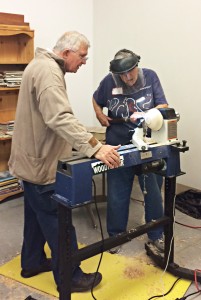 American Woodturner’s June issue tells the story of the work that Dennis has done for two years developing classes for the Bemis School of Art at the Colorado Springs Fine Arts Center.
American Woodturner’s June issue tells the story of the work that Dennis has done for two years developing classes for the Bemis School of Art at the Colorado Springs Fine Arts Center.
There were quite a few hurdles to getting the classroom ready. Bemis does not have a good ventilation system in the classroom, so in order for five people and one instructor to finish bowls, Dennis chose to use an oil finish that allows sanding with the oil to create a slurry instead of dust.
It was also a challenge for the club to select the turning tools. With limited resources, there was quite a bit of controversy as personal preferences were often mistaken for facts.
The club is now developing more classes, in addition to the basic functional bowls class.
Save
Save
Save
 Late snowstorms have broken lots of branches in the Pikes Peak Region. Our native Gambel scrub oaks provided the natural edge roofs for a new crop of Christmas ornaments from Dennis. The storms have kept him in the shop for an early start on the 2017 Christmas season.
Late snowstorms have broken lots of branches in the Pikes Peak Region. Our native Gambel scrub oaks provided the natural edge roofs for a new crop of Christmas ornaments from Dennis. The storms have kept him in the shop for an early start on the 2017 Christmas season.
The base repeats the pattern of dark heartwood surrounded by the lighter sapwood. The perches are blackwood, ebony, or walnut.
Gambel oaks are adapted to Colorado’s variable winter temperatures. The cells in the wood burst when frozen in the live tree, which does not die. This makes a uniquely unstable wood for the turner for it splits easily. It is rare, however, to get this oak in diameters over four inches.
February 13, 2017 – 11:13 am
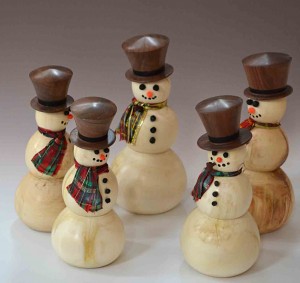 Aspen Snowmen are a natural way to celebrate our native wood, and our famous winter sporting climate.
Aspen Snowmen are a natural way to celebrate our native wood, and our famous winter sporting climate.
Dennis makes the snowmen in several sizes, as sculptures, as 5″ tall upside-down salt shakers, and as Christmas ornaments.
The hats are turned from urban forest trees–primarily walnut.
Save
February 13, 2017 – 11:07 am

A classic peppermill shape with detail created by a laminated turning blank. The shape is revealed when the curves are cut on the lathe. They are rarely identical, but definitely members of the same team.
Dennis makes, sells, and teaches peppermills. These are just one of several classic styles that he prefers.
Save
February 13, 2017 – 10:58 am
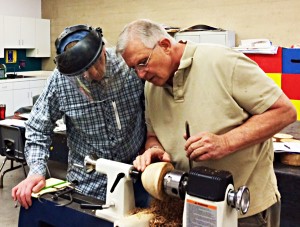 Dennis spent a good part of 2016 developing a woodturning class for the Bemis School of Art. The Pikes Peak Woodturners negotiated a contract for classroom and meeting space at Bemis in exchange for three class and three demonstrations to the public. Dennis was the first volunteer teacher for the club.
Dennis spent a good part of 2016 developing a woodturning class for the Bemis School of Art. The Pikes Peak Woodturners negotiated a contract for classroom and meeting space at Bemis in exchange for three class and three demonstrations to the public. Dennis was the first volunteer teacher for the club.
In this photo, Dennis works with club member Patrick White. Before he rolled out the bowls class, Dennis held a training session with a core group of club members to train helpers for the class. This group, affectionately known as ‘the Usual Suspects,’ has grown to nine members, including the club’s videographer, who donates several Saturdays to providing close-ups of the teacher’s demonstration. The classes are a six-hour, one-day intense course in bowl turning.
Several things have made it possible to teach students to turn a nice 5″ bowl on their first try. Most important are the helpers, who act as safety officers and mentors, as well as a set-up and clean-up crew for this multi-purpose classroom. Dennis also discovered that sanding with mineral oil works effectively to keep down noise and dust. The tools are also ground uniformly on a Tormek system, which allows quick touch-ups during the class. The club’s Education Director, Butch Carlson, is the designated sharpener, so that Dennis can have maximum contact time with the students.
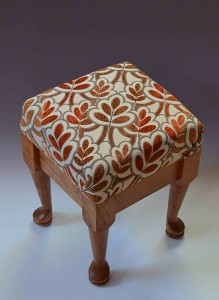
Dennis learned to turn this charming furniture leg from the late Allan Batty. It was a common request in Batty’s day in the English turning shop.
The turning requires cutting off the pommel (square section at top), tapering the leg, and then offsetting it enough to create a dainty ankle just above the foot. It has been identified as a cabriolet leg, or a slipper foot, but it is most accurately described as a pad foot.
This little lady’s stool is just 10′ square, with a 2″ deep cushion to comfort another dainty ankle or two. The wood is American cherry from the NW region of Missouri where Dennis grew up. Greg at Paige Woodworking helped Dennis with the pocket-hole joinery.
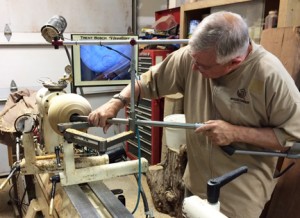 Dennis is making a new round of urns to restock the inventory. In addition to the urn on the lathe, there are other groups of roughed-out vessels all over the shop–on the floor, in baskets, and upside down on the drying rack.
Dennis is making a new round of urns to restock the inventory. In addition to the urn on the lathe, there are other groups of roughed-out vessels all over the shop–on the floor, in baskets, and upside down on the drying rack.
The photo shows the arm brace and the 1″ diameter boring bar that is needed to hollow a vessel as large as a burial urn. This one is still very wet wood.
After the initial hollowing, and several months of drying out, Dennis will remount the vessel and turn the walls to the final, even wall thickness of about 1/4″. He adds threaded inserts and turns a lid from the same wood.
The final stage is sanding and finishing the urn, often with the multi-step patination.
Of course, for the best selection, it is wise to buy a burial urn in advance of the need for it.
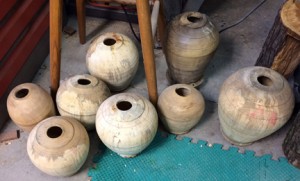
January 8, 2016 – 12:58 pm
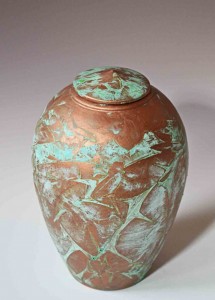 The Mars Urn is an adult-sized burial urn with a threaded lid.
The Mars Urn is an adult-sized burial urn with a threaded lid.
The broad pattern of the patination reminds us of Martian fantasies. The urn is turned from Colorado pine, which you can still smell inside the urn.
$375 includes shipping. Buy it through Square:
October 3, 2015 – 8:07 pm
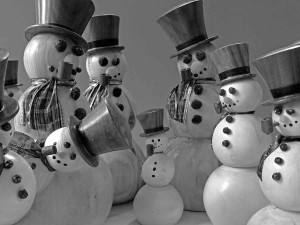 Some of the aspen snowmen made by Dennis were caught here in newspaper black and white by Nick Agar. They appear to be plotting something nefarious while vigorously puffing on their turned pipes. This year’s fellows all have names and distinct personalities. They will appear this winter at the St. Peter’s School Holiday Botique, and then again at the Broadmoor’s Christmas House holiday weekend, November 27 and 28.
Some of the aspen snowmen made by Dennis were caught here in newspaper black and white by Nick Agar. They appear to be plotting something nefarious while vigorously puffing on their turned pipes. This year’s fellows all have names and distinct personalities. They will appear this winter at the St. Peter’s School Holiday Botique, and then again at the Broadmoor’s Christmas House holiday weekend, November 27 and 28.
September 1, 2015 – 5:48 pm

Earlier this summer, Dennis met with Richard Pankratz, a bronze sculptor, to develop a convincing patina on urns made of wood. The happy result is this finish in aged bronze.
The advantage of the faux bronze urn is that the urn itself is lighter in weight, and the use of pine keeps the urns in a very reasonable price range. Many customers contact Dennis to find a bio-degradable urn that is still beautiful enough to display at a memorial service.
Dennis will probably use this finish on more turnings done in plain woods. It does not, however, qualify as a food-safe finish for bowls.
 American Woodturner’s June issue tells the story of the work that Dennis has done for two years developing classes for the Bemis School of Art at the Colorado Springs Fine Arts Center.
American Woodturner’s June issue tells the story of the work that Dennis has done for two years developing classes for the Bemis School of Art at the Colorado Springs Fine Arts Center.








